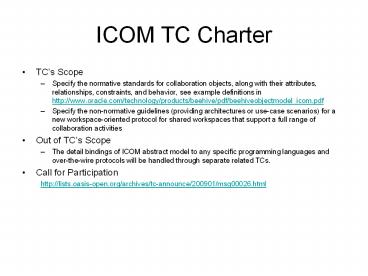ICOM TC Charter - PowerPoint PPT Presentation
Title:
ICOM TC Charter
Description:
... standards for collaboration objects, along with their attributes, relationships, ... ICOM Marker (includes Tag/Label and Category) needs a counterpart in CMIS (new ... – PowerPoint PPT presentation
Number of Views:26
Avg rating:3.0/5.0
Title: ICOM TC Charter
1
ICOM TC Charter
- TCs Scope
- Specify the normative standards for collaboration
objects, along with their attributes,
relationships, constraints, and behavior, see
example definitions in http//www.oracle.com/techn
ology/products/beehive/pdf/beehiveobjectmodel_icom
.pdf - Specify the non-normative guidelines (providing
architectures or use-case scenarios) for a new
workspace-oriented protocol for shared workspaces
that support a full range of collaboration
activities - Out of TCs Scope
- The detail bindings of ICOM abstract model to any
specific programming languages and over-the-wire
protocols will be handled through separate
related TCs. - Call for Participation
- http//lists.oasis-open.org/archives/tc-announce/2
00901/msg00026.html
2
ICOM Abstract Model
- ICOM defines the classes, attributes, and
behavior of collaboration artifacts and
contextual connections - communication artifacts (such as unified message
and instant message), - content management artifacts (such as document,
for text and multi-media content, taxonomy, tag,
recommendation, social bookmarking, saved
search), - coordination artifacts (such as address book,
calendar, task, journal), - teamwork artifacts (such as discussion message,
forum, topic, real-time conference, chat room,
wiki page, blog), - policy artifacts (such as access control,
subscription, reminder, workflow)
3
Mappings betweenICOM and CMIS
- ICOM abstract model can define standard object
types in CMIS - ICOM calendar, task list, forum, topic, address
book, conference, and trash can define standard
folder types in CMIS - ICOM document, unified message, instant message,
wiki page, contact, calendar occurrence, calendar
invitation, task to do, task assignment, etc.,
can define standard document types in CMIS - ICOM subscription, reminder, workflow, and access
control can define standard policy types in CMIS - ICOM n-nary bond can represent a group of 1-1
relationships in CMIS
4
ICOM Entity
- The proposed ICOM entity is a tuple with a
globally unique ID and an optional name. - Virtually all ICOM objects are entities, some of
which can map to CMIS Folder, Document, Policy,
and Relationship objects. - Access to every entity is controlled through an
access control policy. - Each entity can have zero or more markers,
subscriptions, reminders, and bonds associated
with it.
5
Entity and Metadata
6
ICOM Folders
7
ICOM Artifacts
8
ICOM Marker
- ICOM Marker (includes Tag/Label and Category)
needs a counterpart in CMIS (new object type in
CMIS?)
9
ICOM Scope
- A scope is a logical neighborhood (e.g.
community, enterprise, organization, workspace)
in the universe of entities. - An example scope is a community of users that
share a common set of workspaces and are governed
by a common set of policies, such as security and
record management policies. - Enterprise and Organization are two types of
Community.
10
Scope Class Diagram
11
Community of Actors and Workspaces
12
Workspace
- A workspace is a scope that represents a durable
context and place to collaborate. - Workspace involves participants with different
membership roles. A workspace participant can
observe the presence of other participants in the
workspace. - Workspace contains one or more message and
document folders, address books, calendars, task
lists, web conferences, wiki pages, forums, etc. - Examples of contexts are projects, asynchronous
meetings, and libraries. - Workspace can be an integration hub for multiple
CMIS repositories.
13
Workspace Class Diagram































